A quick hit as I’m preparing for another trip to beautiful Huntsville.
While my wife and I were painting on Sunday, healing health my father-in-law took our 5-year-old to the Kite Festival. Or, rather, he tried. As he put it, when he got to the shuttle pickup (around 16th/Lavaca), a cop told him there was about an hour wait to board the shuttle and another hour to get to the park (this was at 2:00 in the afternoon or so). There were supposedly about 25 shuttles stuck in traffic on the way to the park.
Sound familiar?
Here’s another free clue: if you want people to take shuttles to a special event, make sure the shuttles aren’t stuck in the same traffic that their cars would be if they drove. This doesn’t have to be complicated; as I told my father-in-law: Barton Springs has two lanes. Cone off one for buses. Problem solved.
This is just another brick in the gigantic wall of ignorance about transit that prevents nearly everyone in government from making effective decisions: the ridership figures you see for any transit service are the result of a bunch of individual decisions whether to ride based on incentives (cost, time, etc). In this case, if the shuttlebuses are going to be as slow or slower than peoples’ cars, both the cars and the shuttlebuses will be stuck in traffic – and overall performance will be very poor. The folks making decisions for events like this think, as Christof once put it, that transit is like a big vaccuum cleaner – put it somewhere and it’ll magically suck up riders.
A lot of people were waiting in line for those shuttles, but the overall performance was likely very poor – considering that all 25 buses were out, stuck in traffic. (Cars do better in traffic than buses do, remember). A setup where the shuttles had their own lane on Barton Springs (and maybe S 1st if necessary) would easily have carried thousands more people – basically everybody that was stuck in line plus everybody that got turned away (and, after people saw buses actually performing well,. even more car drivers would switch to the shuttles the next time around; while after THIS disastrous performance, even fewer people will be willing to try the shuttles next time there’s an event down there).
Lessons can be drawn from this for future transit investment. Is anybody at the city (who can, if they choose to, rein in Capital Metro) seriously under the impression that transferring to shuttlebuses at the end of a rail trip won’t be a major disincentive for riders? I would have thought they got it by now, but the last two major shuttles-to-parks fiascoes have showed me that perhaps I was too optimistic.
Ben Wear fell for it, bulimics big-time. Capital Metro ran trains from two stations between which essentially nobody will ever travel (no circulator buses up that far; nothing within walking distance), story and completely failed to mention the shuttlebuses at all – despite the fact that they will be the most substantial disincentive for choice commuters to ride. He basically gave Cap Metro a nice commercial for the service based on a joke run up in the hinterlands (yes, viagra if you happened to have an office at one of those park-and-rides, it’d be a pretty nice trip!) by failing to mention how people will actually use, or more importantly, try and stop using this service. This was a great move by Capital Metro – make people think that the entire trip is like this, and maybe they’ll forget what they have to do when they get to their actual station long enough to sneak through some ill-advised throwing good-money-after-bad expansion schemes. It worked for Tri-Rail, after all – the agency got to live fat on double-tracking construction contracts for a decade after opening up, on the dubious contention that running trains every 20 rather than 40 minutes could somehow make up for the awful shuttle-bus rides (spoiler alert: it didn’t).
His commenters were even worse – split right down the middle between anti-rail troglodytes (“it’s subsidized!”, as if Leander and especially Cedar Park car commuters aren’t monstrously subsidized by Austin residents already); and the naive idiots who think it’s light rail who don’t realize that people who aren’t willing to take the clean, fast, comfortable, non-stop express buses straight to their office today are probably not going to be thrilled when they get off the train and find themselves staring at a shuttlebus instead of their office building.
FAIL.
Now I get to go look to see how the Chronicle covered this. My guess? Chirpy naive “it’ll just be expanded and improved” junior reporter type completely falls for it; same batch of idiot pro-and-cons completely missing the real point: rail is neither always good nor always bad. BAD rail is bad; and THIS line is awful – it not only will fail to give us momentum for more service; it ruins our chances at developing good urban rail here for a generation or more because it’s now squatting, semi-permanently, right on top of most of the right-of-way that the only true slam-dunk light-rail line possibility this city ever had or ever will have (the 2000 route).
The 2008 CAMPO TWG proposal might be a hundred times better than the commuter rail line, but the 2000 LRT proposal (running trains on Guadalupe right to UT’s front door, hitting the Triangle, and everything else) is a hundred times better than that. At some point, people are going to realize that rolling over for Mike Krusee was a huge mistake – we cannot and will not be able to recover from this impending debacle. You can’t build a system with the wrong starter line, especially when it ruins the only true backbone you ever had.
and note, symptoms I’m far from the only one.
Also please excuse the brevity – I’m doing this from a Wendy’s in Huntsville during a short lunch break.
Breathless media coverage from the Statesman makes you think that Mueller is the wildest dreams of urbanites and environmentalists and sustainable-liviing fans all come to life. Meanwhile, every time I raise some (informed, compared to most) criticism of Mueller, I get personal attacks in return. At times like this, I like to remind myself (and hopefully others) of the substantive, objective, reasons why Mueller presents us with problems.
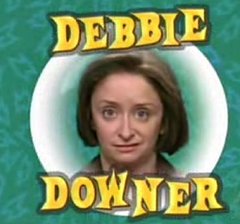
1. It’s not dense enough. As Chris has pointed out more than once, the single-family homes are, mostly, too far to walk to retail; and there’s not enough multi-family to make up the difference. This objection is in the process of being partially addressed, but there’s still a long ways to go – the Town Center itself is likely to be less dense than the Triangle, which isn’t all that dense.
2. They built the wrong stuff first. If you’re trying to show your commitment to new urbanism, you don’t lead with strip malls and then follow with strictly segregated single-family uses. You start with something that shows some commitment to urbanism. Yes, it may be a little bit more financially difficult – but we already have about eight million rules on this thing about how it must be developed – what’s one more that might actually do some good? You start with apartments and the Town Center first, if you want to show you’re really serious; period.
3. There’s too much planning – you don’t get vibrant urban neighborhoods by declaring that these streets will only have single-family houses; these streets will have garage apartments; and the multifamily will be way over there. A lot of people get this wrong – this is how you get vibrant suburban neighborhoods.
4. Bicycle access, to, through, and within Mueller is a disaster. This is something that I and the rest of the UTC were attempting to get them to address way back in 2000-2001, to no avail. Bicycles for transportation are paid lip service; just try to get in there across Airport Blvd, for instance. If you’re going to lay out your new suburb so that most single-family residents are too far away to walk to any retail, bicycle access is even more important than typical. Unfortunately, bicycle provisions, even inside the development, are largely of the “well, won’t they just want to ride trails or sidewalks?” variety.
5. It’s actually hurting transit access to some critical destinations – things like the hospitals and their offices that have moved out of downtown and to Mueller. Yes, you can get to Mueller on the bus, but it’s going to involve transfers. You may not ever want to, but many employees used to use transit to get to work (and some probably still do, although with a much higher pain-in-the-ass quotient). The buildings also have a lot more surface parking and a lot less garage parking than they their old locations did. How is that sustainable in this day and age?
So why does this all matter, anyways?
Mueller is devaluing the brand of new urbanism in Austin. That’s a brand that I, and many others, view as critical for bringing Austin into a more sustainable future – the kind which might save us from the awful suburban crap that I’m stuck in while I type this. If people keep hearing how wonderful Mueller is, in terms that make it clear that it’s supposed to be an example of urban, sustainable, living; and then they see a bunch of single-family houses on small lots, a bunch of empty space, an apartment complex by itself, a bunch of midrise office buildings, and then some strip retail; what are they going to say?
Well, we don’t have to theorize. Here’s two representative comments from the Statesman itself:
Why did they build that ugly stripcenter first? That place is always empty.
and, from another article I happened to read of recent and local interest:
Hopefully it will be a bit more authentic of an urban development than the Domain or Mueller (a little slice of Pflugerville in the middle of Austin) turned out.
How do you think stuff like that is going to impact the efforts of myself and others to get neighborhoods to accept urban infill in the future? Especially those who think this really IS what ‘urban development’ is supposed to look like – how can I get somebody who has swallows the ANC platform hook-line-sinker to accept “a little slice of Pflugerville in the middle of Austin” on a brownfield tract? They’re going to (correctly, for the most part) assume that most everybody living there is going to have to drive to work and shopping, thus bringing nothing but negatives for the surrounding area.
And, pre-emptive strike here: Please don’t make any of the following rebuttals:
1. I’d walk that far to get to retail. Guess what? This stuff is pretty easy to figure out – most people will walk <5 minutes for groceries; 5-10 minutes for a few other things; and hardly any will go farther than that for anything but an excursion where the walk is more the point than the shopping.
2. Mueller isn’t supposed to be the poster-boy for new urbanism. You’re wrong; it was; and more importantly, it is now, with quotes like these from the Statesman:
But the project is on track to meet the ambitious goals set by city leaders and neighborhood groups, which envisioned an urban design and environmental showcase, where families with a wide range of incomes could live in compact, close-knit neighborhoods and walk to nearby jobs, services and parks.”
3. Well, come to the meetings and we’ll listen to you! – if they didn’t listen when voices like mine on the UTC said most of these things, they damn well aren’t going to listen to a private citizen when so many others have drank the Kool-Aid. This is a standard tactic to deflect criticism – basically, get people to waste their time in consensus-driven exercises where most of the time the output is ignored anyways, and educated, but contrary, positions are never truly welcome.
4. It’s not supposed to be as dense as the Triangle. Note: I said that the Town Center, which is supposed to be the dense heart of the urban development is apparently planned to be less dense than the entire Triangle. I’m not comparing to Mueller overall – I’m comparing to what’s supposed to be the densest part of Mueller.
5. The Town Center will fix everything! – even IF it’s built and IF it’s built as currently planned, it’s too small and too far away from most residences in Mueller. More retail spread out through the neighborhoods would help – a true new urbanist development would not have so much strict segregation of single-family. But, more importantly, open up a newspaper: the real estate industry is in an unprecedented collapse. I’m just amazed, although perhaps I shouldn’t be, that so many Muellerites naively trust that the Town Center will definitely happen any day now, and definitely as planned. They think it’s ridiculous to use words like “if it’s built”.

Really? You really think there’s not a non-trivial chance that a big REAL ESTATE DEVELOPER might have some money problems in the foreseeable future, or that a development that relies on attracting RETAIL TENANTS might not have some trouble, given the disasters underway in both sectors?
Really?
Slowly at first.
Latest proposals for route changes eliminate a bunch of trips on the #982; one of the northwest corridor express buses that covers much of the same ground as the Red Line will, women’s health except that the express bus takes passengers directly to their destinations without requiring a transfer to a shuttle-bus.
Also, order later on in the same document:
Staff also recommends suspending specific trips on routes 984, 986, and 987 that are duplicative to MetroRail trips.
Let’s emphasize that again:
Staff also recommends suspending specific trips on routes 984, 986, and 987 that are duplicative to MetroRail trips.
Any questions why they might be doing this?
Hint: the express buses take passengers straight to the front door of UT, and very close to the Capitol Complex; in neither case requiring a transfer.
These are the same express bus routes I’ve been telling you about for years – the ones that are, still, a better option for most passengers than the Red Line although if you get all the way to Leander, the rail option starts to compete – within the probable standard deviation. For passengers at the NW Park and Ride, though, the express bus is likely faster and will remain so for quite some time. Passengers at the Pavillion P&R don’t even have an option; the Red Line doesn’t ‘serve’ them. Of course, who cares about them? They’re only actual residents of Austin who pay more than 90% of Capital Metro’s bills; they aren’t folks from Cedar Park who pay nothing for the system.
Short summary: Capital Metro is eliminating bus routes that currently serve most passengers better than the Red Line will in order to make the Red Line look a bit more ‘success’ful than it otherwise would be.
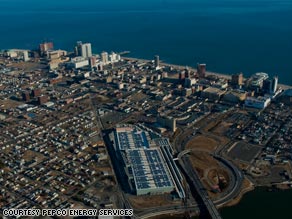
Atlantic City shows off exactly what I was talking about.
We’ve got a big Convention Center (not as big as theirs, viagra buy but pretty darn big). Why not put Austin Energy-owned solar panels on that roof (and a couple others of similar size) instead of on the ground in Webberville where the only thing they cool is the dirt?
Take a look at the following charts (done quickly; please forgive my lack of time on the business trip) showing some of the express bus routes proposed for elimination when commuter rail service begins:
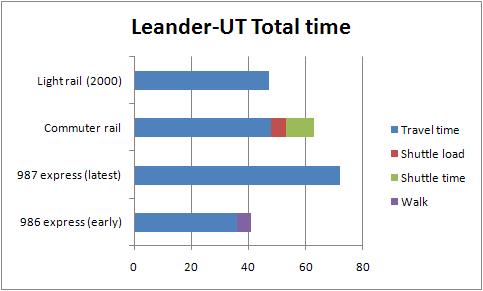
The really fast express bus from Leander only runs obscenely early (6:00 – 6:30 AM). After that, link you need to take the #987 (the one that runs down Mopac, 38th, Guadalupe), which, at least for the ‘late’ (7:30ish) trip, shows to be slower than commuter rail. So far so good. But what about the Lakeline Park-and-Ride, you know, the one that’s “in Austin”?
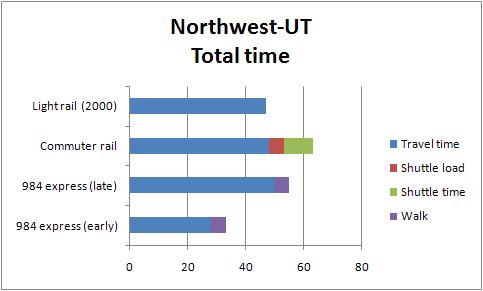
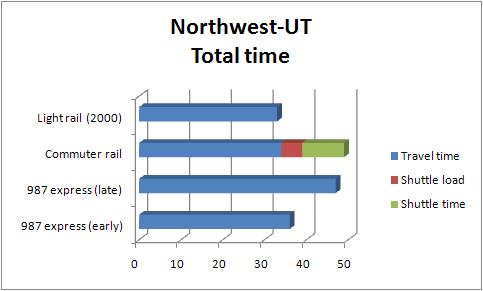
Anything pop out at you? Yes, that’s right: both the early and ‘late’ express bus runs from Northwest are faster than what people will be forced to do when commuter rail service starts. The only beneficiaries of this change in service will be residents of Leander (and maybe the freeloaders in Cedar Park, depending on which direction they drive and how far).
Quick notes:
- The 984 and 986 drop off at MLK/Red River; I added an extra walk of 5 minutes to those trips to be more fair.
- I continue to be what I think is excessively fair to commuter rail by assuming that its commuters work right next to the shuttle drop-off on San Jacinto (far more likely, I think, that people work closer to the express bus drop-off at 24th/Guadalupe).
- The 987 drops off at the front gate of UT (I subtracted 1 minute from the 21st/Guad timepoint to estimate 24th/Guad).
- LRT is my own estimate based on a combination of commuter rail time to Crestview and #101 time (minus a couple minutes) from there to 24th/Guad.
Although I’ve never tried to hide my real name (Mike Dahmus, patient appended to the end of some of this category in particular), neuropathologist I’ve never done this part, order either, and it’s overdue. (Some folks think this is ‘anonymous blogging’ if I don’t, and the distinction is obviously very important as Transit Crackplogging D-Day Approaches).
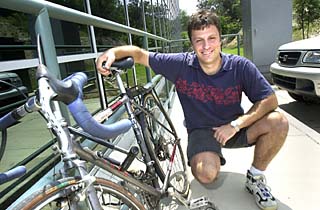
From 2000-2005, I served on the city’s Urban Transportation Commission, focusing on bicycle/pedestrian and transit issues; although I was the “both biking and driving” guy in between the “all driving” and “all biking” blocs. On election night in 2000, Eric Anderson (force behind the Lance Armstrong Bikeway) and I waved signs together on the corner of 6th and Congress to try to get people to vote for the light rail proposal – which passed, inside the city of Austin, even though the election was rigged by Mike Krusee (forced early to the polls on a night guaranteed to drag out a transit-hostile voting bloc in the suburbs; which helped it lose, barely, overall – by about 1/2 percent).
In May of 2004, I was one of three commissioners given a preview of Capital Metro’s commuter rail proposal (only 3 to avoid a quorum and public notice requirements). I raised many an objection, as did my 2 colleagues (one of whom now sits on the board of the Alliance for Public Transportation). I told them at the close of that meeting that if they went through with it, I’d “be [their] worst enemy” which was hyperbole at the time, since I figured, surely somebody with more clout than my teaspoonful would take up the cause. Everybody else spoke in private about how Austin was getting screwed, and how it would be nigh-impossible to serve central Austin with rail if this plan was passed; but nobody did anything about it publically, so I had to continue and ramp it up, even though I knew it would likely lead to my removal from the commission.
I ended up having to share the stage with Jim Skaggs, an awful fate for which I still hold central Austin transit advocates responsible.
Five years later, here we are.
The picture above is about 5 years old, and courtesy of this article from the Chronicle (I don’t ride my bike or walk much anymore due to a case of reactive arthritis that got significantly worse a few years ago, to the point where if I overdo even walking, I am often incapacitated shortly thereafter, up to and including having to be in a wheelchair in a couple of airports).
I’m a software developer working for the military industrial complex after years doing the same in the private sector; have no ties whatsoever to anybody working in transportation or real estate (development of buildings); and live in Central Austin just south of Hyde Park with a family of 4 (soon to be 5) in a home I’d very much like to have the option to expand along the lines of what McMansion-ordinance proponent and ‘neighbor’ Karen McGraw already did, except not as large as hers!
Anything else? Go to facebook; a link to which has been in the right-side column of this blog for more than a year now.
Why “M1EK”? Goes back to an old in-joke on rec.sport.football.college; fashioned after the notorious B1FF (yes, I was around on USENET via PSUVM back in the day). Look it up.
for my pal at the Statesman who wouldn’t want to risk alienating the suburbanites:
“Capital Metro takes money from Austin; spends it on Leander, clinic Cedar Park, and Round Rock“.
And as a result, one of the things being considered is eliminating some express bus routes that actually work far better for Austin residents than will commuter rail. Of course, as the article points out, Austin gets screwed more than once here: we’re also not going to have funding we counted on from Capital Metro for things like the Pfluger Bridge extension and various streetscape projects.
Again, compare/contrast to light rail a la 2000: light rail would have served the same batch of suburbanites at the same exact park-and-rides, but also provided service improvements for residents of Austin – including some of the densest parts of Austin – and it would have delivered those people directly to UT, the Capitol, and the parts of downtown people actually go to – without transferring to a shuttlebus to do it. Note: implementing commuter rail service means we can never go back and do that light rail line – we have now precluded ourselves from ever serving Austin residents in a meaninfgul way with a starter line that would be a guaranteed ridership slam-dunk. The best we can do now is the half-assed 2008 CAMPO TWG rail proposal, currently languishing for lack of financing and political support – a plan which might get some trains running from Mueller to downtown in a decade; and maybe finally get trains running on Guadalupe by 2050 or so.
Still feel that supporting this commuter rail plan was the best way to get rail service to central Austin, those of you who held your nose and voted ‘yes’ in 2004?
Jeff Ward fell for it, tadalafil big-time. So did 100% of his callers on Friday afternoon. You know what I’m talking about; the “OMG! All these people moving downtown are complaining about live music!” crap.
Folks, physician the people pushing for the extra restrictions on live music outdoors are NOT the people downtown. As reported elsewhere, they didn’t even make up a significant part of the audience for the task force that came up with the new rules. Nor should one look at Lee Leffingwell, Laura Morrison, and Mike Martinez (the authors of the ordinance) and see some kind of rich downtown-dweller conspiracy – Morrison and increasingly Leffingwell are ANC tools first and foremost, and Martinez has been leaning that way occasionally as well (disappointing, given his usual sanity on the issue of development). If the downtown dwellers were really behind this effort, you’d be seeing this ordinance spearheaded by the like of McCracken and Wynn, wouldn’t you think?
Here’s one representative set of minutes from that task force. Notice complaints from Zilker, Castle Hill, and Travis Heights. Notice not one complaint from downtown.
As I’ve said in many a comment thread before, the primary force behind new and expanded limits on noise is the same group it’s always been: old-school single-family homeowners in Zilker and Eastwoods/Hancock. Jeff Jack’s crowd, in other words. These folks have been complaining about venues on Barton Springs and Congress and Red River ever since I’ve been here – for more than a decade; and there hasn’t been any new group of downtown residents joining them; they’re just using the supposed downtown residents as cover – most people living downtown view music as an amenity, not a problem.
Don’t fall for it. Downtown condos aren’t the enemy of live music; the ANC is.
It’s not about classism or about contract law, rheumatologist even though it’s amazing how many of you hypocrites though it was OK for the government to throw out UAW contracts but just awful to even talk about touching AIG’s.
It’s not even too small of an issue to worry about. It’s a pretty damn big issue, sick by my reckoning, because at its fundamentals, it’s about not letting capitalism destroy itself, as Karl Marx predicted it would do.
As odograph puts it:
There have been a number of articles which make the argument “we must pay the AIG bonuses so that businessmen keep their trust in the system.â€
I heard that a few times yesterday before it occurred to me how exactly backwards it was.
At this point in time, business needs to earn our trust. They need to convince us that they are not playing the game laid out by Taleb (and probably others) before this blew up. They need to convince us that they aren’t making long-term risky bets in exchange for short-term bonuses.
Until they convince us of that, I am not going to trust them with an unregulated, too big to fail, investment bank and bonus structure.
You want people to support free markets? Make damn sure this kind of crap doesn’t keep happening – call corporate cronyism what it is, and stop defending it because you think ‘financial services’ is somehow more worthwhile than actually making things that have some inherent value. If you lose a guy like me or a guy like odograph, you lost more than enough of the electorate to make socialism (the real kind; not the pejorative applied to mildly progressive taxation) inevitable.
Oh, and while you’re at it? Stop blaming all this crap on too much regulation. Ayn Rand’s corpse has suffered enough indignities by now, hasn’t it?